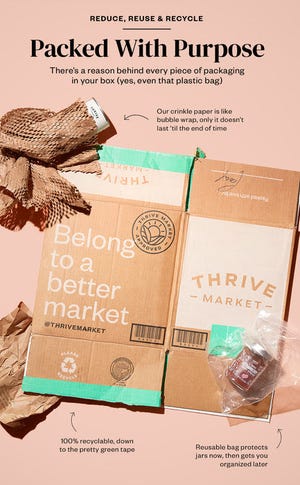Thrive Market is going climate positive. Here's how
The sustainability-focused online retailer is going zero waste, carbon negative and plastic neutral. Read three ways other businesses can do the same.

Thrive Market has always been an eco-conscious enterprise, offering foods made of real ingredients that are safe for the environment, delicious and fairly priced. Already, the e-retailer has committed to a no-air-shipping policy and utilizing all-recyclable shipping materials; it also recently earned B Corp certification. But Thrive Market isn't stopping there: The company recently announced a number of new initiatives that will further shrink its environmental footprint.
According to CMO Jeremiah McElwee, Thrive Market has set a goal to be zero waste certified in 2022, plastic neutral by 2023 and completely carbon negative by 2025.
“We’re on a mission to make healthy products affordable for all Americans, and break down the geographic limitations for people who are underserved and can’t always get healthy products in their home communities,” says McElwee. “At the same time, we don’t want to solve one problem and make other problems, so our mission has always also been about environmental responsibility.”
 How does an e-commerce brand that relies on packaging go plastic neutral? For Thrive Market, it’s all about education. That includes information about what to do with every single product’s packaging at the end of its life, either on the label or on the product’s webpage. “It’s about driving a culture of reductionism, so the first step is with our own private brand and including how to reduce and use the minimal amount of packaging while providing a high quality and stable experience for every product we sell,” McElwee explains. “We lean into reusability and recyclability and, if possible, use a compostable form of packaging.”
How does an e-commerce brand that relies on packaging go plastic neutral? For Thrive Market, it’s all about education. That includes information about what to do with every single product’s packaging at the end of its life, either on the label or on the product’s webpage. “It’s about driving a culture of reductionism, so the first step is with our own private brand and including how to reduce and use the minimal amount of packaging while providing a high quality and stable experience for every product we sell,” McElwee explains. “We lean into reusability and recyclability and, if possible, use a compostable form of packaging.”
Thrive Market is also piloting a program with some consumers who don’t have access to recycling resources. In this model Thrive Market works with a partner to provide consumers with a prepaid shipping box with which they can send the materials back to a facility for upcycling. The good news is that Thrive Market members are enthusiastic about the environment and willing to take the extra step to ensure they’re doing their part.
For retailers who want to get started in minimizing their footprint but don’t know where to begin, McElwee had a few tips to share on how to get started.
1. Start with an assessment.
McElwee recommends that the starting point should always be assessing one’s own process. How do you impact the planet now? It could be waste, plastics or carbon footprint, but regardless the next step is to calculate where you can cut back. McElwee warns not to let perfect be the enemy of the good—the goal doesn’t have to be "zero." Taking any step in the right direction is progress.
2. Think outside the box.
Although Thrive Market starts by using the least possible amount of packaging while maintaining food safety and freshness protocols, McElwee points out that it’s critical not to remain boxed in by convention. Thrive Market has often been told that the reason for a certain plastic packaging or undesirable ingredient is just that it’s always been that way. “It’s amazing how often we do what has always been done before,” he says. “Listen to the crazy ideas. We’ve had ideas about offering products in nonplastic packaging and brands often tell us that they never even thought about it before.”
3. Don’t discount offsets.
McElwee initially didn’t buy into the concept, and wondered why companies couldn’t just eliminate or decrease their energy (or other commodity) usage. But he’s come full circle, and today Thrive Market partners with a carbon fund to protect 500,000 acres of tropical rainforest in Brazil. Indeed, when all else fails and elimination or reduction onsite is impossible, finding organizations that participate in reduction efforts around the world can make a difference. “It might feel abstract in the moment, but you’re making a massive impact,” McElwee says. “It’s empowering communities around the world to take sustainability seriously and have a collective impact.”
About the Author
You May Also Like



